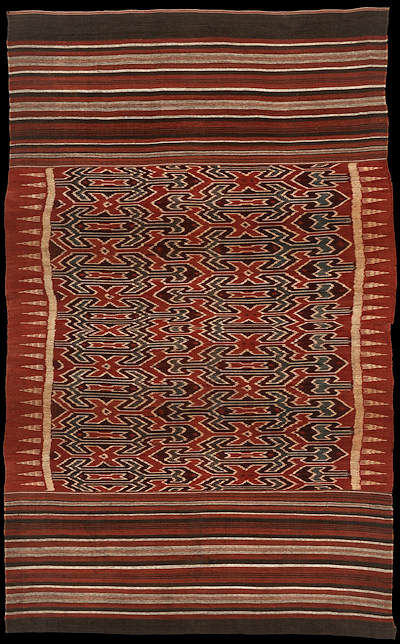| |
 
 | | | |
201 Sulawesi, Toraja
Sekomandi (shroud)  
| | Locale: | Galumpang | | Period: | Late 19th - early 20th c. | | Yarn: | Cotton, hand-spun, single yarn and double-ply | | Technique: | Warp ikat | | Panels: | 4 | | Size: | 182 x 250 cm (5' 11" x 8' 2") LW: 1.37 | | Weight: | 1290 g (45.5 oz), 284 g/m2 (0.93 oz/ft2) | | Design: | Elongated interlocking patterns called lelesepun represent stylised human figures, which symbolize the ancestors which the owner will join in the afterlife. | | Comment: | Sekomandi could be used both as ceremonial sarong and as shroud. Strong tonality and patterning full of tension give this piece a powerful presence. The field was done in double-ply hand spun cotton; the borders in single ply-handspun. Beautiful state of preservation with pleasant patina. Note that in literature shrouds with lelesepun patterning are sometimes called referred to as lelesepun. | | Background: | Chapters on Sulawesi and Toraja. | | Exhibited: | Hong Kong University Museum and Art Gallery, 2017. | | Published: | Ikat Textiles of the Indonesian Archipelago, 2018.
| | Compare: | 064 065 066 067 214 | | Sources: | Nearly identical to 19th C. seko mandi in Dallas Museum of Art, Nr. 1983.126, depicted in Alpert, Eyes of the Ancestors, Plate 65. Also near-identical to those in Yale Art Gallery, ILE2006.4.34, ILE2006.4.23, ILE2006.4.34 and ILE2006.4.30, all from the Spertus and Holmgren collection. Very similar to early 20th C. example in Krefeld Textil Museum, Nr. 16008, depicted in Khan Majlis, Indonesische Textilien, Wege zu Goettern und Ahnen, Fig. 746; and to one depicted in Van Hout, Indonesian Textiles at the Tropenmuseum, Fig. 208. Also very similar to one described as lelesepun in Kahlenberg, Textile Traditions of Indonesia, Fig. 24; and to seko mandi in Holmgren and Spertus, Early Indonesian Textiles, Fig. 25., which has an excellent article on the meaning and ancient origin of the motifs. | | |

©Peter ten Hoopen, 2024
All rights reserved.
|
|


